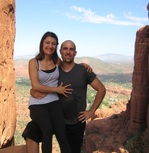As we traveled from Agra to Jaipur, Neda and I were still feeling exuberant from the amazing sites of the day, but were starting to grow restless at the one-dimensional relationship we seemed to have with every Indian person we met. In Delhi and Agra we found that every single interaction we entered into culminated in someone asking for money, for us to buy from their store, or was some other attempt to extricate money from us. 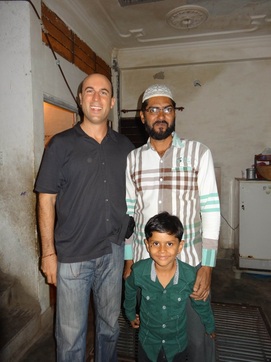 Jeff with Saleem and his son Kabir In Jaipur, that all changed. We had sent out some couch requests on our favorite website Couchsurfing.org. Some people warned us this was a bad idea in India, but CS’s format of screening people through past references has always worked well for us and it seemed that India was a place where we would really benefit from having some authentic interactions. We were accepted by Saleem Khan and his wonderful family, who live in a 300 year old home in the old city of Jaipur. I can tell you that our driver seemed pretty surprised when Saleem met us at one of the city gates and then spoke to him briefly in Hindi before leading our car through the winding alleyways that led to his family home! Once at the house, we were greeted to delicious chai (black tea, milk, and a bit of sugar) and mutton briyani, complements of the various ladies who live in the house. Saleem’s house is bursting with the energy of family – himself, his wife and kids, as well as his mother and various brothers and sisters and their family all live there.
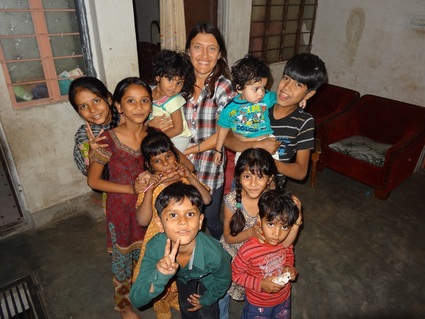
Neda with all the kiddos!
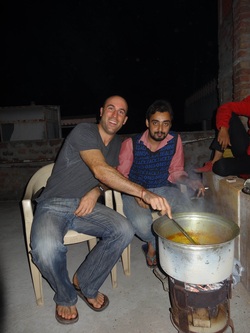 Jeff cooking up a storm! In total, 15 people reside here daily and even more were in town for the Diwali festival as guests. We were among those guests and loved the time we spent playing with the children, talking over chai with Saleem and his genial brother Kabir, and watching the workings of the bustling household. On our 2nd night there, we were invited to help cook a delicious Mutton Korma from scratch, watching as cooking expert Jeckie cooked down the onions in ghee, added a variety of fresh spices, mutton, and milk in order to create a creamy and spicy delicacy. We ate the meal on the family’s rooftop, where a typical night of winter dusk sees thousands of kites being flown by children from the rooftops and where during the Diwali festival the sky erupts with fireworks launched from all over the city.
During the days we did sightseeing with our driver. He drove us up to the picturesquely situated Amber Fort – which lies on a hilltop 11km outside of town. Built in 1592 by Maharaja Man Singh, a general of Akbar’s Army, the fort boasts the furnishing of a palace, with the impressive Jai Mandir (Hall of Victory) inlaid with mirrors along with intricate carvings that catch the eye in a thousand places. Amber Fort is watched over by the even higher situated Jaigarth Fort. Jaigarth’s interior is not as impressive as Amber, but the watchtower there affords splendid views of Amber and surrounding countryside. On the way back from the two forts, we stopped at the Jal Mahal (water palace), a beautiful sandstone building which seemingly floats in the middle of a dam-produced lake that was created in the 16th century. It is said to have been created to house the Maharaja’s harem so that they would be separated from all possible corruptions.
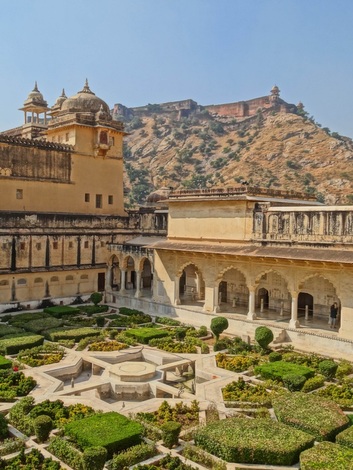
Jaigarth Fort view from Amber Fort's gardens
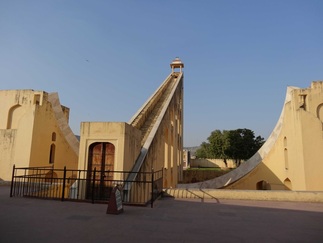 Jantar Mantar Observatory - biggest sundial Heading back into town, we visited Jantar Mintar, the royal observatory. It consists of an open-air plaza full of giant instruments that take varying measurements of the nighttime sky, including the most massive sundial we have ever seen, the 90m high Samrat Yantra. Using all the different instruments together, has the ability to glean a comprehensive picture of the celestial sky. Across the street from Jantar Mintar is the City Palace, the home of the Rajasthani Maharajas ever since Maharaja Jai Singh decided to move from Amber Fort and founded the city of Jaipur. It contains a textile museum explaining costumes of the region and rulers over the years as well as an interesting hall showing the history of the different Maharajas from scholar kings to warriors. At Pitam Niwas Chowk square, the beautiful painted peacock doorways enchant visitors while the private royal palace of the Chandral Mahal looms in the background.
The main event was the night of the 13th, the celebration of Diwali. Diwali, or the festival of lights (http://www.diwalifestival.org/diwali-new-year.html), marks the Hindu New Year and is one of the most major celebrations in India. Hindus believe that Lakshmi, the Goddess of wealth and luck, visits home that are brightly lit and so the whole city comes alive with light. Children make “deeps”, or small clay lamps to attract the goddess to their homes in the hopes of new clothes and toys. In Jaipur, Diwali is taken beyond just individual homes as the city’s many bazaars are garishly decorated and illuminated in a display that makes Christmas look like childsplay!
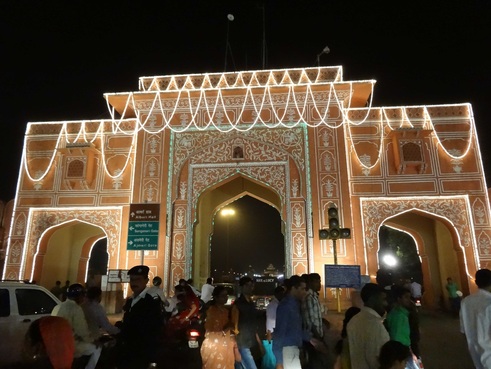
Jaipur City Gates decorated for Diwali
On Diwali night, our host Saleem and one of his good friends Asif honored us by driving us through the whole city on their motorbikes. Neda sat behind Saleem and I sat behind Asif as we cruised from bazaar to bazaar watching the kaleidoscope of lights. I think the star of David is also an ancient Hindu symbol, because some streets were just lined with hundreds of them, confusing me for a moment into thinking it was a different festival of lights! The gates of the old city were also lined with lights, making for a dazzling entranceway into the bazaars. We rode alongside whole families on single motorbike (with the women and girls dressed up in their fancy Diwali dresses) and behind autorickshaws packed with 4 or 5 kids in the back, their slack face jaws staring out at the iridescent scene. Jeff managed to take a few videos of the whole scene, click here to see one of them and the rest are on flickr. For a little while as we cruised along the streets, we blended in with the crowds and felt like we were a part of the whole scene and not just tourists there to observe from the outside. This was the most precious gift that Saleem and Asif could give us.
After leaving with a joy from Delhi, we left Jaipur with heavy hearts. In just a few days we felt like we had become a part of the family, and we knew we would miss the close knit community that Saleem was a part of. It really contrasts with our loosely knit family and friends – spread out everywhere from Philadelphia to Saint Louis to Boston to Austin to Bulgaria and another half dozen other countries as well. But for a brief moment to be a part of someone else’s quilt brought a warmth to our hearts we know will stay with us for a long time.
In 2012, we have celebrated 3 New Years so far. The Western New Year found us in a mountain lodge in Stara Zagora with Neda’s old friends, a raging fire and snow falling around us. The Thai/Lao New Year found us dancing in the streets of Luang Prabang, soaked to the bone with all the splashing water and a bit inebriated from the generosity of the local folk there. And finally, the Hindu New Year found us surrounded by a surrogate family amidst the glow of millions of lights. If that’s not what travel is all about, I don’t know what is! To see all our pics (and videos!) of Jaipur and Diwali – click here: http://www.flickr.com/photos/67011297@N07/sets/72157632011293721.
If you read our previous post about New Delhi, you would know that we were feeling pretty harried with all the machinations required to book our travel through the “Golden Triangle” of Delhi to Agra to Jaipur and back. After many attempted scams, our driver did arrive on Saturday morning and we felt a swelling of relief that the ordeal was over. The driver, Rimesh, seemed like an affable fellow who spoke good English. He was telling us about how his family lives north in the mountains and how he works in Delhi to support them. Then, he pulled over on the side of the road and said, “My wife only visits a few times a year from the mountains and one of those times is during Diwali (the Indian Festival of Lights). So my cousin Kirssna will be your driver. We’ll just pull over here and pick him up.”
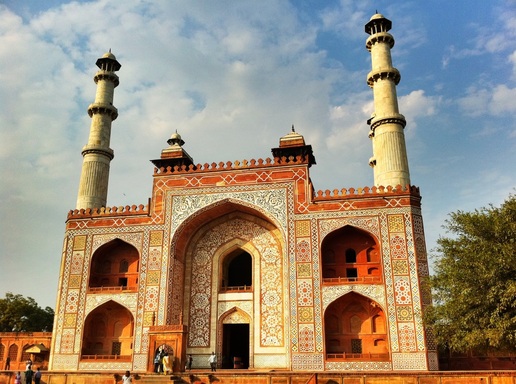
Akbar's Tomb - Sikandra
Uh, oh. Our frazzled nerves from the previous few days had us wary of any changes that we hadn’t been told about. But we had little choice and a call to our travel agent assured us it wasn’t a problem. But in the end the change to Kirssna as a driver seemed to shroud the whole journey under a veil of bad luck. Kirssna spoke much less English than his cousin and as we petered out of traffic-congested Delhi with mosquitoes flying through our car, we discovered upon closing the windows that our “air conditioned” car had no working AC. Kirssna attempted to get it fixed at a road side shop, but in the end this only succeeded in killing off the alternator, leaving us broken down on the side of the road about 45 minutes from Agra. After a sweltering 2 – 3 hour wait for the waiting for a different car sent by the travel agency to pick us up, a 4-6 hour journey had ballooned into a 10 hour one and we were exhausted.
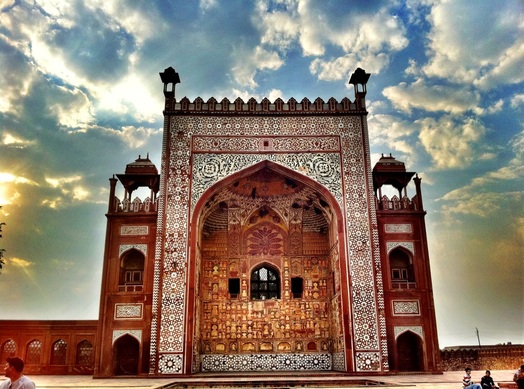
Akbar's Tomb as the sun starts to set
Still, the drivers of the new car at least gave us a taste of what the region had to offer as we stopped in Sikandra to view the tomb of Akbar the Great, the Mughal Philosopher King who was uncommonly tolerant of different religions and viewpoint within his realm. He penned a philosophy known as Din-i-llahi (Faith of God), that spoke of the unifying thread of truth found in all religions. His mausoleum, which predates the Taj Mahal by several generations, is an imposing and delightful blend of red sandstone inlaid with marble geometric patterns that harkened us back to our travels through Andalusia. Though we hadn’t anticipated seeing it so late in day, as the sun set over the ancient tomb the sandstone blazed forth as if on fire and the visual effect was such that we instantly felt glad we had continued on this journey that seemed plagued with problems. That sentiment quickly eroded as, despite our exhaustion, the drivers insisted on taking us to a marble making shop, where an interesting description of the techniques used at the Taj Mahal to inlay the marble with semi-precious stones (called pietra dura) was followed by a harsh and hard sell by the shopkeeper. Insisting we were too tired to even think of shopping, we left the shop with a curse at our backs and feeling that the goodwill in India was in short supply. We were unceremoniously dumped at our hotel and our failed calls to our driver left little choices for dinner save the Pizza Hut next door. Just a few days in India and we were already eating at our second chain due to simply being unable to find authentic restaurants! It was fun however, to see the unique Indian items like the Spicy Paneer Quesadillas and Chicken Tikka Masala Pizza. We headed to bed early in anticipation of our sunrise viewing of the Taj.
As morning came, we sat outside our hotel futilely trying to contact our driver. Realizing he wasn’t coming and that we would miss the sunset, we hired a private rickshaw and headed to the Taj ourselves. The sun was just lifting from the sky and we trundled through the massive red sandstone gate to get our first glimpse of this wonder of the world.
And a wonder it is. The great Indian Poet, Rabindranath Tagore once likened the Taj to “A Teardrop on the Face of Eternity”. We stood gazing the at the wondrous sweeping curves of its onion-like white marble dome glowing sweetly to greet the new day. Its towering minarets stand guard over the tomb of Mumtaz Mahal and the view of the background sky is totally clean due to the huge elevated marble platform the Taj sits upon. The tourists surrounding us fell away. Time fell away. And for a moment there was just the beauty of this thing captivating our minds, flowing through our hearts.
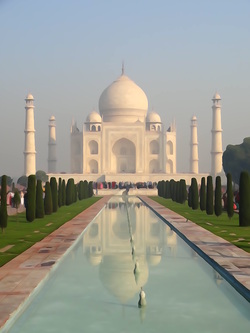 The Taj Mahal was built by the great Mughal builder Shah Jahan upon the loss of his wife after the birth of their 14th child. It took 20,000 craftsmen and workers from all over the world 22 years to finish the masterpiece – a building meant to represent the heavenly realm where Shah Jahan’s wife rested. In this way, it had parallels to the gorgeous palace of the Alhambra, which was an attempt by the Sultans there to create heaven on earth. What is most striking about the place is not something that can be captured in pictures. It is the juxtaposition that strikes one when in its presence. It both instills a deep peace at its beauty but also calls forth the yearning for love each of us feels – that makes each of us human. After the ordeal of the past few days, it felt like the Taj gave us that gift – it made us feel human again. We found ourselves laughing and joking as we left, energized by the visit and determined to feed our pain bodies no longer, but to embrace this trip no matter what it brought us.
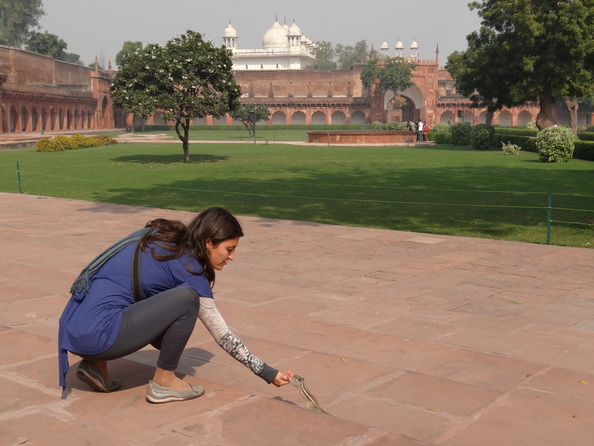
Neda greets a chipmunk from within the palace complex of Agra Fort. The Sultan's Mosque sits in the background
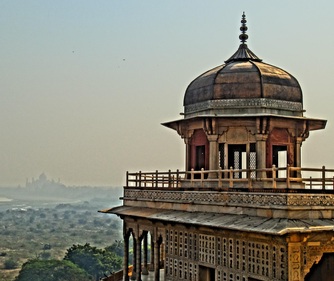 Nice view for a prison The rest of the day breezed by with a stream of marvelous sites. We finally located and were picked up by our driver, got a great breakfast of boiled eggs, herbed parathas, and dal in our bellies, and headed to Agra Fort, built by the aforementioned Akbar and retrofitted by his grandson Shah Jahan. Like the Red Fort in Delhi, Agra Fort started as a military base and later became a palace where royal affairs were carried out. Perhaps the most striking building at the fort was the Khas Mahal, a wonderfully carved marble palace that became the prison of Shah Jahan when his son Aurangzeb seized the throne and threw his father in prison. I found great irony in this because Shah Jahan is said to have immediately slain all competitors to his throne upon coming to power. But despite all this violence and grasping, his own karma came back to haunt him as the one person he wouldn’t slay, his son, seized the throne from him. His perch in the palace-turned-jail, however, did provide a stunning view of the Taj over the Yamuna River where Shah Jahan could look at his beloved each day.
From Agra Fort, we headed 40km west of Agra where we stopped at Fatehpur Sikri, an abandoned city built by the ubiquitous Emperor Akbar. Akbar built this city out in the boondocks in honor of the Sufi Shaikh Salim Chisti, who had prophesized here that Akbar would father an heir to the Mughal throne. When the prophecy came true, Akbar set out to build this “perfect city” of good fortune and move his capital there. The plan only lasted for 15 years, after which Akbar died and the chronic water shortages of the area left the city abandoned for the more consistent water supply that had existed in Agra.
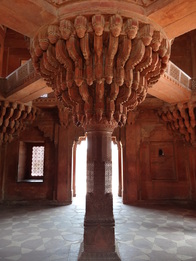 Diwan-i-Khas The result is an eerie city that had become a ghost-town within the same generation it was constructed. Our favorite site in the palace complex of the city was the Diwan-i-Khas (Hall of Private Audiences) with its intricately carved planked ceiling connecting a grouping of “wasps nests” at the 4 corners of the room and in the center. The hall was used for one of Akbar’s favorite pastimes – religious debate and discourse. We also loved the Panch Mahal, a five-story pavilion that reduces in size each floor until only a small gazebo remains. From there, Akbar relaxed while playing pachisi using his slave girls as pieces. This guy was certainly living up an Emperor’s life!
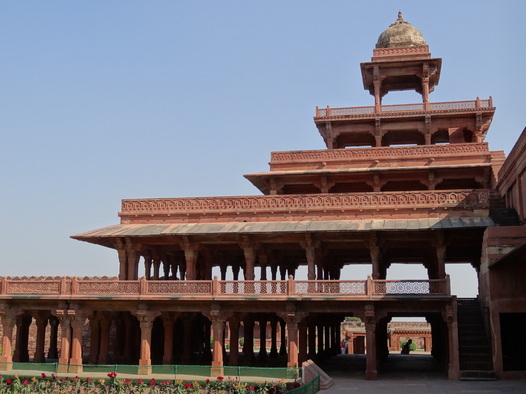
Panch Mahal - from the top the Emperor presided over giant games of pachisi in the courtyard with his servant girls as pieces!
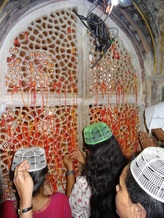 Finally we left the palace complex and headed to the great mosque of Jama Masjid, which contains the beautiful white marble tomb of Shaikh Salim Christi. His descendants still maintain the tomb and it is a flocking point for pilgrims wishing to bear children. Wishing for the good fortune the Sufi saint bestowed upon Akbar, they come to his mausoleum to offer prayers and tie little red strings around the lattice-work marble screens surrounding his tomb.
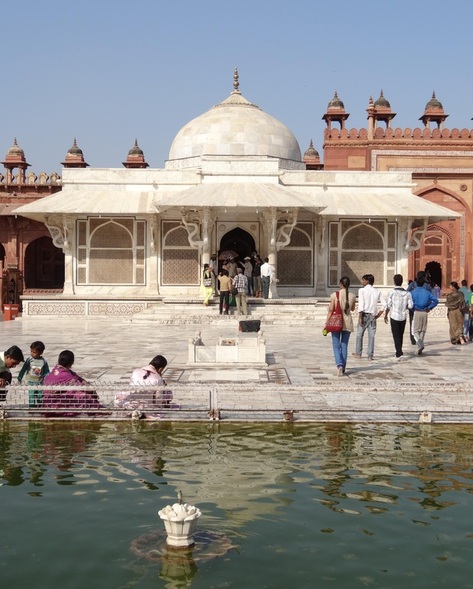
The Marble Tomb of Shaikh Salim Christi
By the time we got back into the car and started our 5 hour journey to Jaipur, we were exhausted but invigorated. The remains of the Mughal empire around Agra were a legacy of beauty, the celebration of life, and the many reminders of its impermanence. We looked forward to the next stop in the Golden Triangle, where we would celebrate Diwali in the Pink City of Jaipur and try out Couchsurfing in India for the first time!
Ahhh, India. Literally landing there was like stepping into a new world. A really, really dirty one. Upon exiting from the plane at 6am, our throats caught at the stringing sensation of inhaled smog. Our morning taxi ride to our hotel was like driving through a war zone of slowly awaking people along the roadside and a haze that seemed to set an implacable gloom over the whole city. We spent a few hours planning our onward journey, but were puzzled by seemingly fully booked trains and hard to reach bus stations with little information. So we took a brief nap and decided to worry about all that after our first foray into an Indian city.
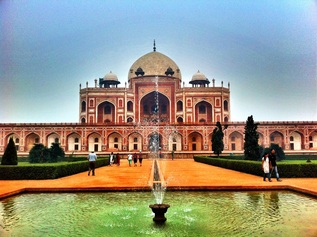 It started positively with a local restaurant serving delicious Punjab food. We were salivating over our perfectly spiced Aloo Gobi (potato and cauliflower curry), Mutter Paneer (green peas, cubes of pressed white cheese, and a creamy tomato curry sauce), and garlic naan. We got ourselves an Indian SIM card and set off on the Delhi Metro (the most crowded we have ever experienced) to Humayun's Tomb, the mausoleum of the son of the great Mughal Emperor Babur who had conquered Northern India from Kabul, Afghanistan in 1526. The tomb is an impressively massive structure built out of red sandstone and white marble – a merging of Persian and Indian influences. But the heavy fog combined with the smog nearly smudged out the sun and left the view slightly less mesmerizing.
With a bit of time to wander in the evening we headed for Connaught Place, which lies in the center of New Delhi. It was the beginning of things going downhill very quickly for us in Delhi. We had read that the Deli Tourism Authority was in the area, but it was over an hour since it was supposed to have closed, so we just wandered around the various rings of streets emanating out from the center where the metro stop was looking for restaurants. At one point we turned and saw a place labeled “Delhi Tourism Authority” with an “Incredible India” symbol on its frosted glass door. I said to Neda, “oh, look there is the Tourist Office – is it still open?”. We pushed on the door and it looked like they were about to close, but one man there gestured for us to sit and said he could stay open a bit longer.
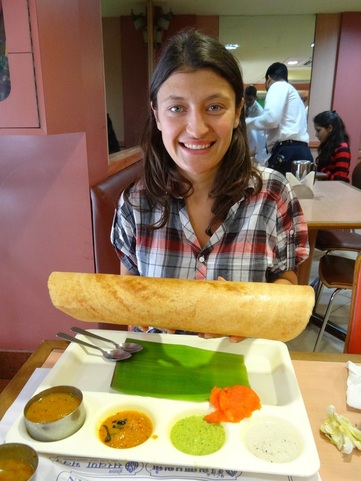
Mmmm...that is a big dosa! We ate at the two restaurants pictured here and above 3x each!
We just wanted information on transportation options out of the city to Agra (home of the Taj Mahal) and then onward to Jaipur, the Pink City. Known as the “Golden Triangle” this popular tourist route covers many major sites in India. The man proceeded to sweet talk us into listening to him entirely too long, planning out a whole itinerary and offering to book trains for us that we knew were full, before I asked, “Is this the tourist office? Because it seems more like you are a travel agent.” He then lied to my face and said, “Of course, you didn’t know the Delhi Tourist Office offered these services?” Well, those services came to over 400 euros per person for things he couldn’t possibly fulfill. We wisely left without paying a dime, but tired of having spent much of the day trying to plan our escape from Delhi with no success. We resolved to finish the task the next day without any more scams.
We headed off to the train station the next day, where we had read you could book trains directly and find out if any of the trains had seats remaining with a “tourist quota” that couldn’t be purchased online. The tourist office for this was supposed to be on the second floor. When we entered the train station, there was a barrier in front of the steps and a man approached us to tell us that the tourist office was closed for repairs but that we could buy the reserved tickets at the Tourism Office. He kindly pointed to where it was on the map and told us to have a good day. Since he hadn’t asked for anything we took him at his word and headed back to find the real Delhi Tourism Office. We rode the subway the one stop back to Connaught Place and as we were exiting a man walking along side of us started a casual conversation with us, asking what we thought of the Delhi Metro. As we continued to walk with him alongside of us, he found out we were going to the tourist office and said that it could be difficult to find because of all the fake offices. He said he was walking right by it though, and could point it out to us. Well, you may have guessed by now that this man had followed us (I know freaky!) from the train station and was just playing us to get us to yet another fake tourism office! This one was located on the same street as the tourism office (see pic below), making it difficult to know which is real since there are no street numbers anywhere!
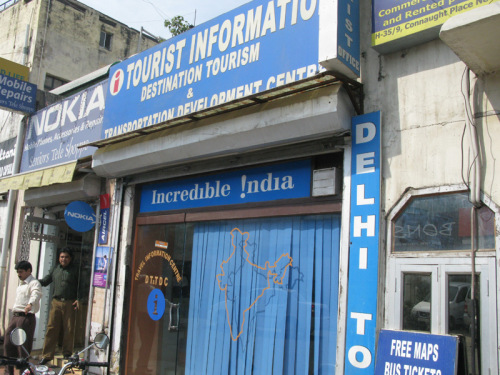
The fake tourist office we were led to the 2nd time...notice the "D.T.T.D.C" on the door - the real initials of the tourist agency are "D.T.D.C." Pretty tricky, huh? Photo courtesy of leave me here: http://leavemehere.wordpress.com/2009/10/27/destination-india/
After another rigmarole with some similar themes as the previous time (“do you want to go to visit Kashmir and stay with a family there?”), and an inability to give us good information on public transport without planning a trip for us, we wisened up to the fact that this wasn’t a real shop and fled again, feeling foolish and exhausted (though at least not robbed!). Finally, we found the Government of India Tourism office on 88 Janpath road, the only office with a number marked on it! The man there told us that many of the trains and buses would be difficult to procure during this busy time (the popular Diwali Festival starts on Nov. 13th), but suggested we try a real travel agent who was next door or go back to the train station and try our luck again. Exhausted at this point, we went next door and finding a government licensed tourist agency, Destination India, we simply paid the extra money to hire a driver for 5 days to take us to Agra then to Jaipur and back to Delhi before leaving on a train to Armirtsar, home of the Golden Temple. Coming in at just about $45/day including two nights of hotels as well, it seemed just a heck of a lot easier than dealing with the congested and seemingly dysfunctional public transportation around Delhi.
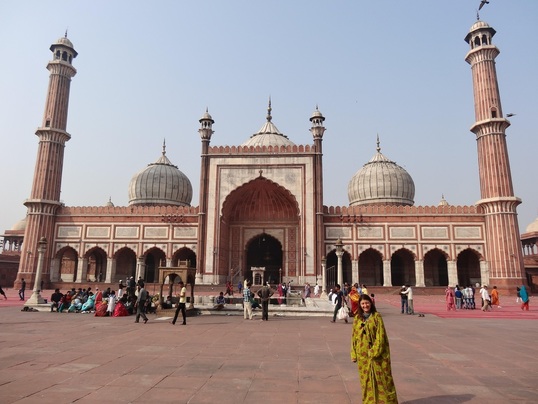
Neda sporting her moomoo at Jama Masjid Mosque in Delhi. Personally, I thought she looked good in puke yellow...
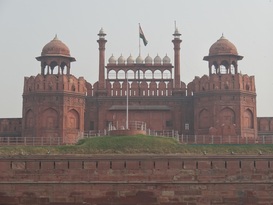 The Red Fort That night was a difficult one for us as we marveled and mourned at how elaborate the schemes were to trick us and rob us. We felt we couldn’t trust anyone in the city and just wanted to get out. We crossed our fingers that our driver would show up the day after next and vowed to enjoy our last day in Delhi, which we did. We visited the massive Jama Masjid mosque where Neda was forced to don a hilarious moo-moo that steamed her like a dumpling under the mid-day heat. Then we visited the Jain temple Lal Mandir, with its accompanying bird hospital. The Jain religion, originating around the time of Buddhism, holds the tenant of ahimsa (non-violence) as paramount and the bird hospital is seen as an embodiment of that. There, the caretakers rehabilitate everything from pigeons to peacocks that the faithful bring to them when found wounded.
Finally, we visited the Red Fort, a palace built by Mughal Emperor Shah Jahan (who also built the Taj Mahal), where we saw the scattered remains of the red sandstone and marble structures that once held a small city within a city. The next day we woke up early and our driver was waiting for us outside the hotel. Yay! We weren't a scammed – or were we!? Read about our crazy trip to Agra next… To see all the pics of our time in Delhi, click here:
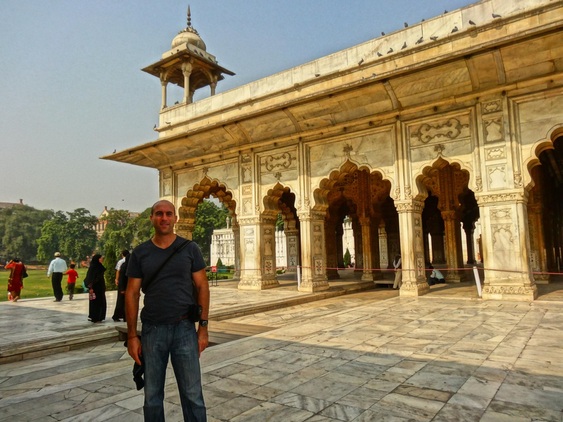
A flowing river of fresh water once flowed through the canal in the background through the palatial buildings of the Red Fort
What I remember most from my childhood in Bulgaria is the summers, when we were off school and roamed the neighborhood all day long. One of the people that always accompanied me was my friend Tania, from our apartment building. We spent our days sewing clothes for our dolls, planning elaborate picnics in the nearby fields, even attempting to smoke her mom’s cigarettes. Tania and I were inseparable for many of these years, until my parents immigrated to the United States in 1997. The internet was just becoming more common but nobody in my country had a computer or email, so our only way of connecting was through the phone or through mail. This left most of my friendships on hold until I reconnected with some of them, including Tania, through email addresses I acquired nearly 10 years later on my first trip back to visit Bulgaria.
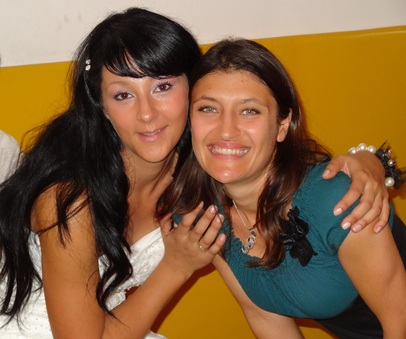
Tania and I at the wedding
We had the chance to spend some time with Tania and her husband Georgos last winter, when they were back for a visit in Bulgaria. This was the first time we saw each other in 15 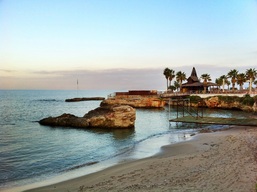 Star Beach on Crete years! We found out more about her moving to Crete and meeting the father of her adorable little daughter Marilena. At that dinner a year ago, they invited us to their wedding, and we vowed to attend despite any logistical hiccups that might arise getting to a fairly remote island like Crete. For me it was important to not let our ties wither again as they had when I departed for America all those years ago. Also, their wedding on the island was a great way to start the next leg of our adventure.
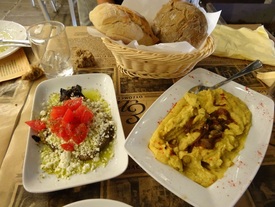 Delicious Greek food in Thessaloniki The best route down to Crete first involved a 9 hour bus trip to Thessaloniki followed by a domestic flight from there to Crete. It was impossible to do in a day, so we made a stopover in Thessalonki to explore the second largest city in Greece. We found a rich history from its 3,000 year existence as part of the Roman, Byzantine, and Ottoman empires. We visited the beautiful White Tower on the coast, the ancient mausoleum turned church in the Rotunda, and the ruins of the ancient Roman Forum. We came upon a cute tavern, the only bustling restaurant along the seafront promenade. Most people eating here were Greek, so we decided to give it a try, were in for a wonderful surprise. Platters of pureed fava beans, roasted eggplants and vegetables covered with tomatoes and herbs, chickpeas with traditional sausages, veal chunks surrounded by a mote of creamy eggplant puree, and delicate feta cheeses crowded our table along with dry red wine and tsipouro (a drink similar to Bulgarian rakia). The assortment of tapas style dishes left us stuffed to the brim and thankful for one of the best meals on our travels thus far!
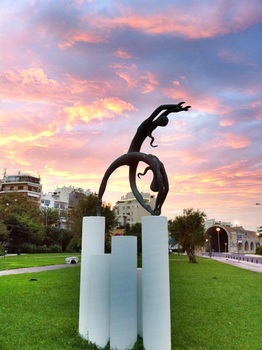
Fiery sunset over this statue in Heraklion, Crete
The next day, we flew to Crete to meet the bride and groom! We spent the days before the wedding hanging out with their family (where Jeff could practice his Bulgarian) and enjoying home cooked meals from Tania’s mom! She spoiled us with Greek and Bulgarian dishes every day and made us enormous salads covered in homemade olives from Georgios’ mom here in Crete (which were by far the best olives I have ever tasted!). We played with Marilena, their beautiful 2 year old daughter, and marveled at how she could transition from Bulgarian when speaking to Tania, to Greek when speaking with Georgios. We took a day trip to Heraklios, the capital city of the island, and visited the old Knossos ruins of the Royal Palace of the Minoans (the place where King Minos is said to have lived, where the Minotaur was spawned and later killed by Theseus, and where Daedalus and Icarus took forth on an ill-fated flight from the confines of the nearby labyrinth). The ruins were different than many we have visited because the site was partially restored by an archeologist named Arthur Evans in the early 1900s. He interpreted the spaces he found and built over them as he thought their function was intended, which was quite controversial in hindsight since many of his assumptions were probably wrong. The site left us disappointed on one hand as it was difficult to differentiate true 4,000 year old ruins from reconstructions, but also thankful for some of the replica drawings he posted all around and the reconstruction’s vision of what life in the palace may have been like.
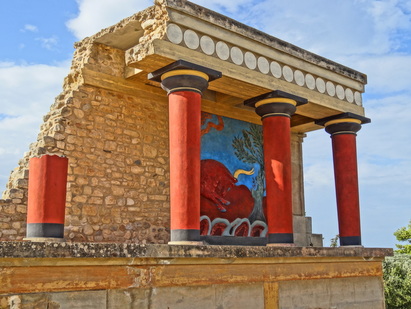
Bull painting and reconstruction at Knossos
The culmination of the trip was the Cretan wedding. Crete is the largest and most populous of the Greek isles and was once the center of the aforementioned Minoan civilization, which is 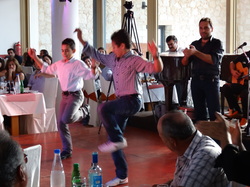 Pentozali dancers the oldest recorded civilization in Europe. The wedding was a traditional Greek Orthodox wedding combined with the baptism of Marilena. After a short ceremony in the church for the wedding and then the baptism, the guests were showered with delicious food and Cretan wine. The Cretan sheep cheese was exceptional and we enjoyed all the different meats and accompanied side dishes, like the creamy Cretan rice pilaf served with baked mutton. Perhaps most interesting was the live traditional Cretan band playing the Cretan lyra and the laouto. The music was accompanied by a traditional dance, the Pentozali, performed by the guests. The dance would start like a Bulgarian horo, in a circle, with everyone following the same steps. Somewhere along the line, the first person in the horo, usually a man, breaks off into a solo dance performing a series of jumps while smacking the bottom of his shoes. Some women also performed solo dances in the middle of the circle involving dips and turns.
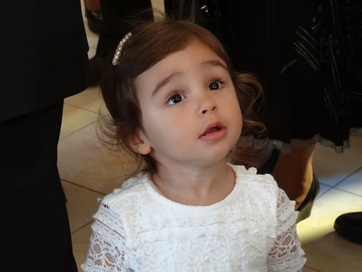
Marilena, all prettied up for her baptism
It was fascinating to watch these ancient dances and customs being passed down from generation to generation and preserving the bond these people share with their past. It was also warming to be part of the wedding of one of my best friends from my past and to renew the bond we have shared for all these years. Like the Cretans, who take pride in their past and celebrate the history that makes them who they are, I felt a deep gratitude for the ties of my own past and my ability to celebrate them with an old friend on a special day in her life. As Marilena just learned to say this weekend, “Zhivi i Zdravi!” (To Life and Health!) Click here for our pics from Thessaloniki and Crete.
|








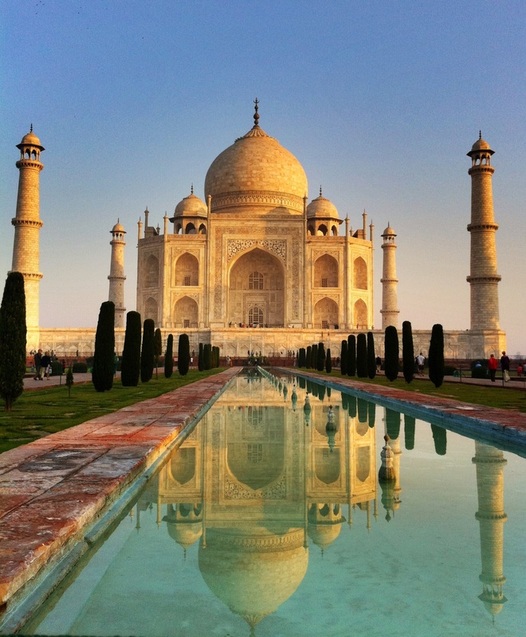
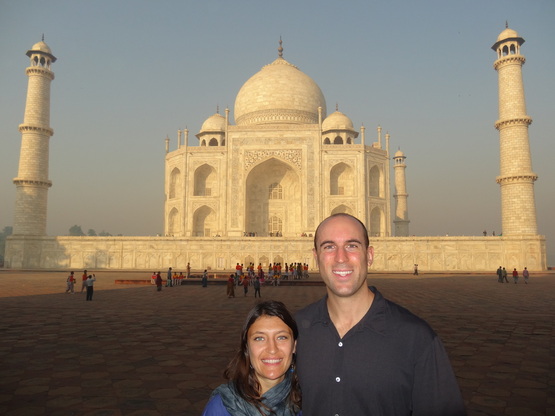



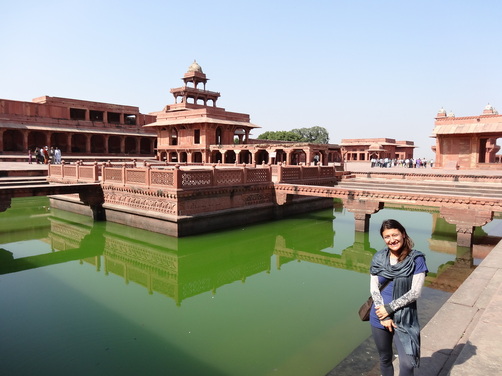




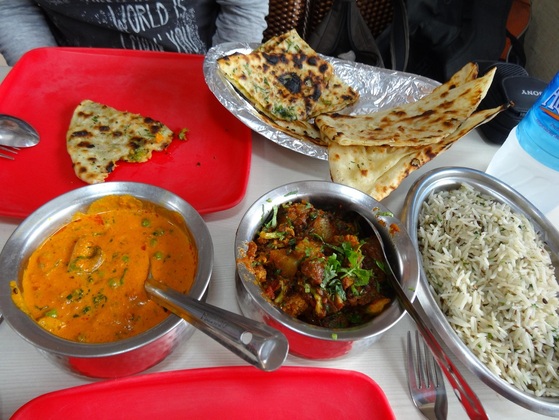













 RSS Feed
RSS Feed